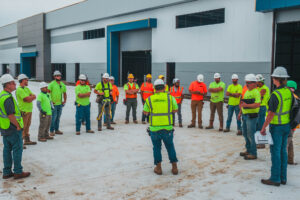Emerging Trends in Multi-Family Amenities
In today’s competitive multi-family housing market, amenities are no longer just an afterthought — they’re a driving force behind leasing success and long-term tenant retention. As developers, brokers and property owners, you’re recognizing renters are looking for more than just a place to live. They seek a lifestyle that aligns with their values and daily needs. This shift has led to the rise of highly-curated amenities that foster community, convenience and well-being.
Top Amenities in Multi-Family Construction
Amenities play a crucial role in setting a development apart in today’s highly competitive multi-family market. Renters are seeking a living experience that enhances their lifestyle. The right combination of features can elevate a property’s appeal, making it more desirable and increasing resident satisfaction. Some of the most sought-after amenities include:
Rooftop Decks and Outdoor Lounges
Maximizing underused spaces, rooftop decks are becoming a must-have in urban settings. With features like fire pits, grilling stations and lounge seating, these spaces offer residents a chance to socialize while enjoying skyline views.
Communal Gardens and Green Spaces
Sustainability and wellness are top of mind for renters today. That’s why many properties are incorporating communal gardens, landscaped courtyards and even green rooftops. These spaces not only enhance aesthetics but also contribute to mental and physical well-being.
Indoor and Outdoor Fitness Areas
Traditional gyms are evolving into dynamic fitness hubs. Complexes are now including indoor/outdoor workout areas, yoga studios, climbing walls and courts for the game that’s sweeping the nation, pickleball. Nearly 73% of renters prioritize a fitness center when choosing a place to live, making it one of the most sought-after amenities in multi-family developments. Catering to a wellness-focused demographic, these amenities enhance the resident experience and create a sense of community.
Dog Parks and Pet Spas
Approximately 70% of U.S. households own a pet. Pet-friendly communities are no longer just an option — they’re an expectation. From on-site dog parks to self-service dog wash stations, developers are prioritizing pet-friendly features to attract renters who consider their furry companions a top priority when choosing a place to call home.
Coworking and Flex Spaces
As remote and hybrid work models are now the norm, dedicated coworking spaces within residential buildings are in high demand. Private conference rooms and comfortable workstations provide residents with functional alternatives to their day-to-day work experience.
Knowing Your Multi-Family Community Audience
A successful multi-family development isn’t just about including the latest amenities — it’s about understanding the target demographic and aligning offerings with their lifestyle preferences. Nowadays, providing a sense of community is becoming more and more prevalent within multi-family developments through its amenities.
Young professionals in urban markets may prioritize rooftop lounges and work spaces, while suburban renters may value family-friendly amenities like playgrounds and walking trails. Another example is Ronco Construction’s recent project The Parkwood, an independent living community in Sioux Falls, S.D. This facility features centralized amenities like a full-service restaurant, business center, game room, fitness studio and beauty parlor designed to meet the needs of the active retirement-aged audience. By tailoring amenities to the right audience, developers can maximize occupancy rates and long-term retention.
Balancing Costs and Value of Amenities
Now while those highly-curated amenities can attract the renters, they can also drive up the cost of a project. That’s why it’s important to bring the general contractor onto the project early. An experienced multi-family GC can help you balance the amenities that appeal to today’s renters while ensuring they remain cost effective.
By having your construction manager partner involved upfront you can:
- Employ value engineering to find the most cost-effective materials and construction methods that don’t impact quality or delivery. At Ronco, the preconstruction team specializes in value management — optimizing structural and service costs to allocate more of the budget toward high-quality finishes and furnishings.
- Evaluate amenity phasing where some amenities are delivered early, but others might be a phase two or three after the initial lease up to help manage cash flow.
- Leverage established relationships with suppliers and subcontractors to get the best pricing.
- Identify long-lead items early to minimize the impact on schedule.
Bottom line — early collaboration with your construction partner can optimize design, materials, and phasing, allowing you to create communities that are financially viable while meeting the resident’s wish lists.
By recognizing what modern-day renters truly value, you can bring developments to life that offer more than just a place to live — create engaging and connected communities.





